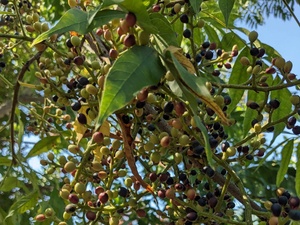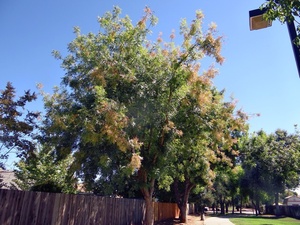 Pistachio nut hulls on a female Chinese Pistache (Pistacia chinensis).Pistache Trees are trees in the genus Pistacia, which contains 10 to 20 species. They are members of the cashew family, which also contains cashews, mangoes, pepper trees, sumac, and poison oak.
Pistachio nut hulls on a female Chinese Pistache (Pistacia chinensis).Pistache Trees are trees in the genus Pistacia, which contains 10 to 20 species. They are members of the cashew family, which also contains cashews, mangoes, pepper trees, sumac, and poison oak.
Common Pistachio (Pistacia vera) is a deciduous tree from central Asia. It produces the commonly sold pistachio nut. About 98% of pistachio nuts commercially grown in the United States are grown in California, and 96% of California-grown pistachio nuts are grown in five counties of the San Joaquin Valley: Kern, Madera, Fresno, Kings and Tulare Counties.1 Although pistachios are not among the agricultural crops that Woodland is famed for, it is very likely possible to grow pistachio nuts here. However, pistachio harvests are not easy for home gardeners to manage, both because they produce urushiol, the same allergenic oil produced by Poison Oak, and because they are easily contaminated by aflatoxin from commonly occurring molds. Common Pistachio trees are usually either male or female. Male Common Pistachio trees are ranked 8 out of 10 on the Ogren Plant Allergy Scale, indicating that they tend to cause fairly severe hay fever.
Mt. Atlas Pistache (Pistacia atlantica) is a deciduous tree from southwestern Asia and northern Africa. It usually grows to 25 feet tall. It is sometimes used as a rootstock for commercial pistachio farming, with Common Pistachio (Pistacia vera) grafted onto its roots. Mt. Atlas Pistache trees are usually either male or female, but they can occasionally bear both male and female flowers on the same tree. Male Mt. Atlas Pistache trees are ranked 8 out of 10 on the Ogren Plant Allergy Scale, indicating that they tend to cause fairly severe hay fever. Mt. Atlas Pistache trees are planted as street trees on 1st Street and 4th Street.
 Chinese Pistache (Pistacia chinensis) trees in West Cline Alley at Wayne Cline Park. Photo by queerbychoice.Chinese Pistache (Pistacia chinensis) is a deciduous tree from central and western China. It is planted everywhere in Woodland. In the city's parks alone, it is planted at Beamer Park, Campbell Park, Charles Brooks Community Swim Center, City Hall, City Park, Dave Douglass Park, Dick Klenhard Ballfield Complex, Everman Park, Gary Traynham Park, Grace Hiddleson Park, Jeff Roddy Memorial Park, John Ferns Park, Joseph Schneider Park, Pioneer Park, Ralph Harris Park, Rick Gonzales, Sr., Park, Spring Lake Park, Wayne Cline Park, William Crawford, Sr., Park, Woodland City Cemetery, Woodland Opera House, Woodland Public Library, Woodland Sports Park, Woodland West Park, and Woodside Park. Additionally, it is planted as a street tree on 1st Street, 2nd Street, 3rd Street, 4th Street, 5th Street, 6th Street, Alice Street, Bartlett Avenue, Beamer Street, Bliss Avenue, Carnegie Way, Clover Street, College Street, County Road 102, Court Street, Cross Street, Dead Cat Alley, Depot Street, Dog Gone Alley, East Gibson Road, East Gum Avenue, East Keystone Avenue, East Main Street, East Street, Elliot Street, Elm Street, Grand Avenue, Hays Street, Highway 16, Jackson Street, Johnston Street, Laurel Street, Lemen Avenue, Locust Street, Main Street, Marshall Avenue, Matmor Road, North College Street, North Street, Oak Avenue, Palm Avenue, Pendegast Street, Pershing Avenue, Pioneer Avenue, Sports Park Drive, Sutter Street, Walnut Street, West Kentucky Avenue, West Keystone Avenue, West Main Street, and Woodland Avenue.
Chinese Pistache (Pistacia chinensis) trees in West Cline Alley at Wayne Cline Park. Photo by queerbychoice.Chinese Pistache (Pistacia chinensis) is a deciduous tree from central and western China. It is planted everywhere in Woodland. In the city's parks alone, it is planted at Beamer Park, Campbell Park, Charles Brooks Community Swim Center, City Hall, City Park, Dave Douglass Park, Dick Klenhard Ballfield Complex, Everman Park, Gary Traynham Park, Grace Hiddleson Park, Jeff Roddy Memorial Park, John Ferns Park, Joseph Schneider Park, Pioneer Park, Ralph Harris Park, Rick Gonzales, Sr., Park, Spring Lake Park, Wayne Cline Park, William Crawford, Sr., Park, Woodland City Cemetery, Woodland Opera House, Woodland Public Library, Woodland Sports Park, Woodland West Park, and Woodside Park. Additionally, it is planted as a street tree on 1st Street, 2nd Street, 3rd Street, 4th Street, 5th Street, 6th Street, Alice Street, Bartlett Avenue, Beamer Street, Bliss Avenue, Carnegie Way, Clover Street, College Street, County Road 102, Court Street, Cross Street, Dead Cat Alley, Depot Street, Dog Gone Alley, East Gibson Road, East Gum Avenue, East Keystone Avenue, East Main Street, East Street, Elliot Street, Elm Street, Grand Avenue, Hays Street, Highway 16, Jackson Street, Johnston Street, Laurel Street, Lemen Avenue, Locust Street, Main Street, Marshall Avenue, Matmor Road, North College Street, North Street, Oak Avenue, Palm Avenue, Pendegast Street, Pershing Avenue, Pioneer Avenue, Sports Park Drive, Sutter Street, Walnut Street, West Kentucky Avenue, West Keystone Avenue, West Main Street, and Woodland Avenue.
In fact, the Urban Forest Resource Analysis published by the City of Woodland in 2018 indicated that Chinese Pistache trees were a close second only to London Plane trees as the most prevalent tree species in Woodland's city-maintained urban tree canopy, with 1,420 Chinese pistache trees comprising 10.0% of all public, city-maintained trees in Woodland. This report declared that "Woodland relies most on two species"—London Plane and Chinese Pistache trees—for good reason: "These species dominate the inventory, providing significant benefits and a sense of place. They are key to sustaining the benefits provided by the public tree resource, as well as preserving the essence of Woodland for years to come."
But how could two species that are both imported from faraway places possibly provide the best "sense of place" or "essence of Woodland"? Why are non-native trees from far away so heavily favored over trees that are native to California, perhaps even native to Yolo County, or even native to Woodland itself?
Chinese Pistache trees are usually planted for their fall color. They can grow to about 60 feet tall. They prefer full sun and are very drought-tolerant. These trees are either male or female, so they do not produce seedlings unless there are both male and female trees in the area. To avoid unwanted seedlings, people tend to plant male trees virtually exclusively. You can see why there are some advantages for the municipal government in filling Woodland with trees that grow well here but don't produce any seedlings.
However, the male trees that are planted all over town are the ones that produce the pollen! Male Chinese Pistache trees are ranked 8 out of 10 on the Ogren Plant Allergy Scale, indicating that they tend to cause fairly severe hay fever. If there's a Chinese Pistache tree near your home—which, if you live in Woodland, there almost certainly is—then it's almost certainly male (though if it's female, you'll know it by the sight of the ripening nut hulls and the huge number of seedlings sprouting under the tree). Those male trees near your home are definitely inundating you with highly allergenic pollen from about March through May. If you get sniffly each year from March through May, it could easily be the fault of the Chinese Pistache near your home. And if that Chinese Pistache is one of the 1,420 Chinese Pistache trees planted and maintained by the city, then the city is spending your tax dollars to make you sick and put you at risk of developing asthma.
See the hay fever page for help in combatting the overplanting of hyperallergenic male trees and also coping with the effects of such overplanting.


